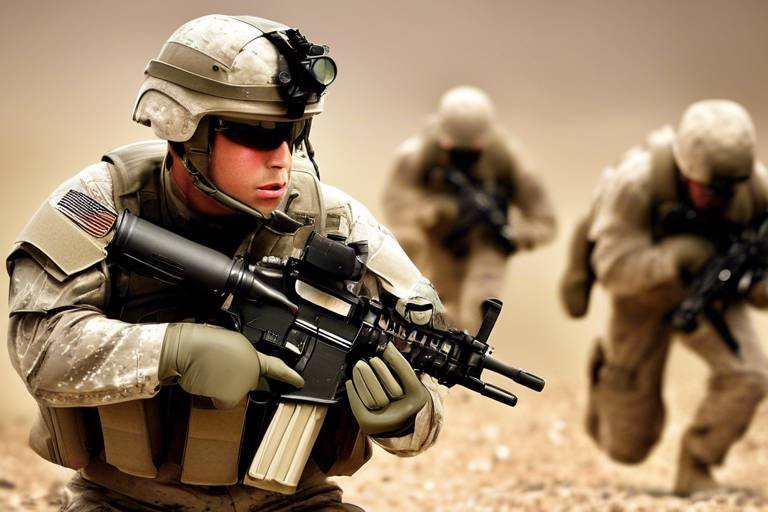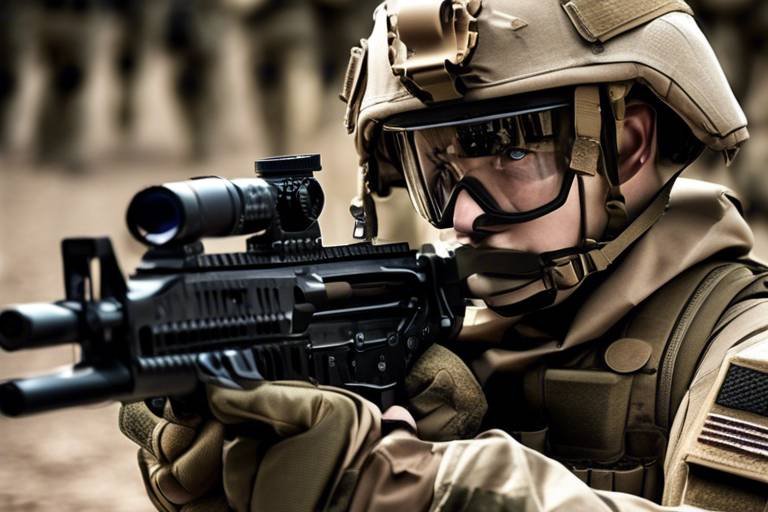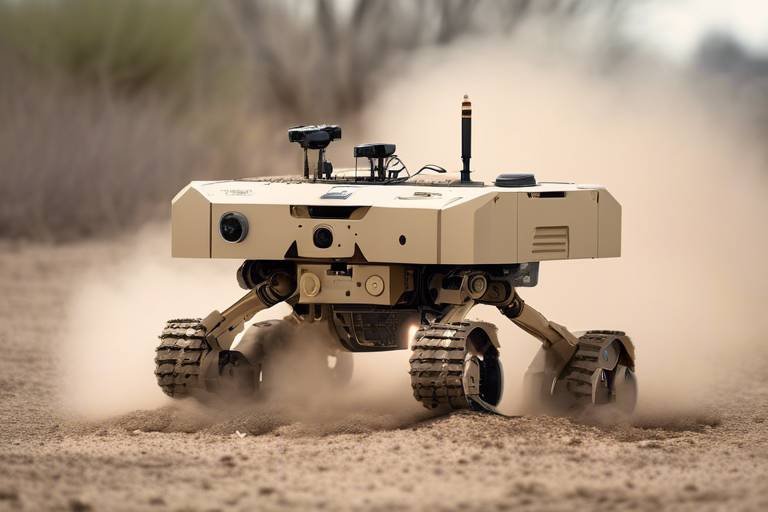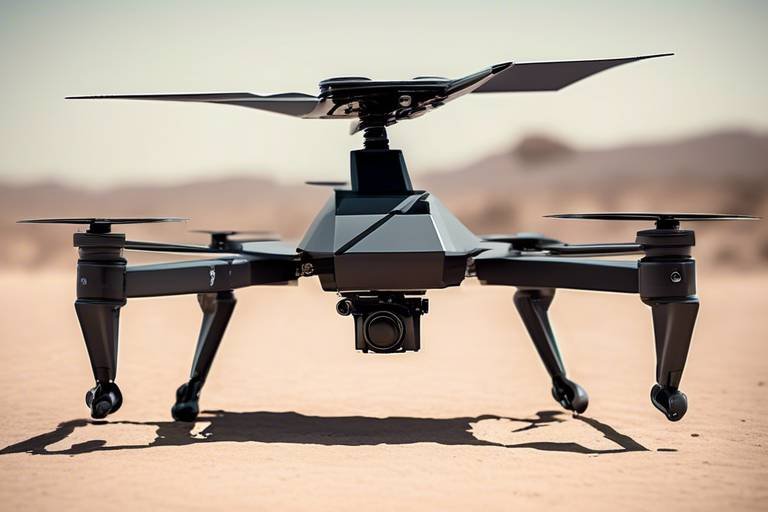AI-Enabled Decision Making in Complex Combat Environments
In today's rapidly evolving battlefield, the integration of artificial intelligence (AI) into military operations is not just a trend; it's a revolutionary shift that is reshaping how decisions are made in complex combat environments. Imagine a scenario where commanders, faced with the chaos of warfare, can rely on AI to sift through mountains of data, providing real-time insights that can mean the difference between victory and defeat. This article dives deep into how AI enhances decision-making processes in military scenarios, focusing on its applications, benefits, challenges, and future implications.
To appreciate the profound impact of AI on military operations, we must first understand what AI encompasses. At its core, AI refers to systems that can perform tasks that typically require human intelligence, such as reasoning, learning, and problem-solving. In military contexts, AI applications range from autonomous drones to sophisticated data analysis tools that assist in strategic planning. The technology plays a pivotal role in enhancing strategic decision-making, allowing military leaders to make informed choices based on comprehensive data analysis rather than gut feelings or outdated information.
The integration of AI into military decision-making processes brings numerous advantages that can significantly enhance operational effectiveness. One of the most notable benefits is the improved accuracy of decisions made under pressure. AI systems can analyze vast amounts of data in real-time, providing commanders with actionable insights that are both timely and relevant. This capability is crucial in combat scenarios where every second counts, and decisions need to be made swiftly and confidently.
AI systems are designed to provide commanders with real-time insights and data analysis, significantly improving situational awareness on the battlefield. By aggregating data from various sources—such as satellite feeds, reconnaissance reports, and troop movements—AI can create a comprehensive picture of the combat environment. This enhanced awareness enables military leaders to make informed decisions that can adapt to the ever-changing dynamics of warfare. For example, consider a commander who can visualize enemy positions, troop strengths, and potential threats all at once—this capability allows for strategic maneuvers that were previously unimaginable.
One of the critical components of AI's effectiveness in military operations is its ability to utilize data fusion techniques. These techniques integrate diverse data sources, enhancing the overall understanding of complex combat scenarios. By combining information from different sensors and intelligence reports, AI can create a unified operational picture that aids in decision-making. This capability not only streamlines the process but also reduces the likelihood of errors that can arise from relying on isolated data points.
Another fascinating aspect of AI in military contexts is its use of predictive analytics. This technology allows military leaders to forecast enemy movements and potential threats, enabling them to strategize effectively. By analyzing patterns in historical data and current intelligence, AI can predict where an enemy might strike next or identify vulnerabilities in their defenses. This foresight is invaluable in planning operations and allocating resources efficiently, ultimately leading to a more successful outcome.
Despite the myriad benefits, the implementation of AI in military decision-making is fraught with challenges. One of the primary concerns is the ethical considerations surrounding the use of AI in warfare. Questions arise about accountability, the potential for unintended consequences, and the moral implications of autonomous systems making life-and-death decisions. Additionally, issues related to data security and the need for robust infrastructure to support AI systems cannot be overlooked. Military organizations must navigate these challenges carefully to harness the full potential of AI while ensuring ethical standards are upheld.
While AI offers remarkable capabilities, it is essential to recognize that it should augment human decision-making rather than replace it. The synergy between humans and AI can lead to more effective outcomes in combat environments. Military personnel must understand how to leverage AI tools to enhance their decision-making processes, ensuring that they remain at the helm of command.
Effective training programs are crucial for military personnel to adapt to AI tools. These programs should focus on ensuring that soldiers can utilize AI technology to its fullest potential during operations. By fostering a culture of continuous learning and adaptation, military organizations can prepare their personnel to work seamlessly with AI systems, ultimately leading to more informed and effective decision-making.
Building trust in AI systems is vital for successful implementation. Military personnel must feel confident in the reliability of AI technologies to make critical decisions. Strategies to enhance reliability include rigorous testing, transparent algorithms, and continuous feedback loops that allow for improvements based on real-world experiences. A trusted AI system can empower military leaders to make decisions with greater confidence, knowing they are supported by accurate data and predictive capabilities.
Looking ahead, the potential future developments of AI in military operations are both exciting and daunting. As technology continues to advance, we can expect to see even more sophisticated AI applications that will shape warfare strategies. From enhanced autonomous systems to advanced data analytics, the future of military operations will likely be defined by the seamless integration of AI technologies. The implications for warfare strategies are profound, as military leaders will need to adapt to the rapidly changing landscape of combat, where AI plays a central role.
- What are the main benefits of using AI in military decision-making?
AI improves accuracy, speed, and situational awareness, allowing commanders to make informed decisions quickly. - How does AI enhance situational awareness on the battlefield?
By integrating data from various sources, AI provides a comprehensive view of the combat environment, helping leaders understand the dynamics at play. - What challenges does the military face when implementing AI?
Challenges include ethical concerns, data security issues, and the need for robust infrastructure to support AI systems. - How can military personnel effectively collaborate with AI?
Through training and adaptation, military personnel can learn to leverage AI tools to enhance their decision-making processes. - What does the future hold for AI in military operations?
Future developments may lead to more advanced AI applications that will significantly influence warfare strategies and military operations.

Understanding AI in Military Contexts
Artificial Intelligence (AI) has emerged as a transformative force in various sectors, but its impact on military operations is particularly profound. In the chaotic realm of warfare, where decisions must be made in the blink of an eye, AI serves as a powerful ally, enhancing the decision-making process. But what exactly does AI entail in military contexts? At its core, AI refers to the simulation of human intelligence processes by machines, particularly computer systems. This includes learning, reasoning, and self-correction. In military operations, these capabilities are harnessed to improve strategic planning, operational efficiency, and combat readiness.
One of the most exciting aspects of AI in the military is its ability to process and analyze vast amounts of data at unprecedented speeds. Imagine a battlefield filled with drones, sensors, and surveillance systems, all collecting data continuously. AI systems can sift through this information, identifying patterns and anomalies that human analysts might miss. This capability allows military leaders to gain insights into enemy movements, troop deployments, and potential threats, making it easier to devise effective strategies.
Moreover, AI technologies are not just about data analysis; they also play a crucial role in automation. For instance, autonomous vehicles and drones can carry out missions without direct human intervention, reducing the risk to personnel. However, this raises important questions about the ethics of using AI in combat. As military organizations adopt these technologies, they must navigate complex ethical landscapes, ensuring that AI applications align with international laws and humanitarian principles.
To better understand how AI functions within military contexts, it's helpful to look at its specific applications. These can be broadly categorized into:
- Intelligence, Surveillance, and Reconnaissance (ISR): AI enhances the capabilities of ISR systems, allowing for real-time data collection and analysis.
- Logistics and Supply Chain Management: AI optimizes supply chains, ensuring that troops have the necessary resources when and where they need them.
- Training Simulations: AI-driven simulations provide realistic training environments for soldiers, improving their readiness for combat scenarios.
In summary, understanding AI in military contexts involves recognizing its potential to revolutionize how military operations are conducted. From enhancing situational awareness to automating complex tasks, AI is not just a tool; it is a game-changer that can significantly impact the outcome of military engagements. As we move forward, the integration of AI into military strategies will continue to evolve, presenting both exciting opportunities and formidable challenges.
- What are the main applications of AI in the military?
AI is used in intelligence analysis, autonomous systems, logistics, and training simulations. - How does AI improve decision-making in combat?
AI processes data rapidly, offering insights that help military leaders make informed decisions quickly. - What ethical considerations are associated with AI in warfare?
Ethical considerations include compliance with international laws, accountability for autonomous actions, and the potential for unintended consequences.

Benefits of AI-Driven Decision Making
In today's rapidly evolving military landscape, the integration of artificial intelligence (AI) into decision-making processes has emerged as a game-changer. Imagine a battlefield where decisions are made not just based on intuition, but on a wealth of data analyzed in real-time. This is not science fiction; it’s the reality of AI-driven decision making. By leveraging AI, military operations can achieve a level of accuracy and speed that was previously unimaginable. With the ability to process vast amounts of data at lightning speed, AI empowers commanders to make informed decisions swiftly, significantly enhancing operational effectiveness.
One of the most profound advantages of AI in military contexts is its capability to provide enhanced situational awareness. In the chaos of combat, having a clear understanding of the battlefield is crucial. AI systems can analyze data streams from various sources—drones, satellites, and ground sensors—integrating this information to create a comprehensive picture of the environment. This data fusion technique not only improves awareness but also allows for quicker responses to emerging threats.
Moreover, AI excels in predictive analytics. By examining historical data and identifying patterns, AI can help forecast enemy movements and potential threats. This foresight enables military leaders to strategize effectively, positioning their forces in anticipation of enemy actions. Think of it as having a crystal ball that not only tells you what might happen next but also equips you with the tools to prepare for it. The result? A more proactive approach to warfare, where strategies are not just reactive but are designed to outmaneuver opponents.
Let’s consider a few specific benefits of AI-driven decision making:
- Improved Accuracy: AI systems reduce human error by providing data-driven insights and recommendations.
- Faster Decision-Making: With real-time data analysis, decisions can be made in seconds rather than minutes or hours.
- Data Management: AI can sift through enormous datasets, extracting relevant information that would be impossible for humans to process in a timely manner.
However, the benefits of AI extend beyond mere efficiency. The technology also fosters a culture of collaboration between humans and machines. Rather than replacing human intuition and experience, AI acts as a powerful ally, augmenting the decision-making capabilities of military personnel. This partnership not only enhances the effectiveness of operations but also builds a more resilient military force capable of adapting to the complexities of modern warfare.
In summary, the integration of AI into military decision-making processes offers a myriad of benefits that can transform the way operations are conducted. From enhancing situational awareness and predictive capabilities to fostering collaboration between humans and machines, AI stands as a pivotal component in the future of military strategy. The question is not whether AI will play a role in warfare, but how effectively military leaders can harness this technology to gain a decisive edge on the battlefield.
- What is AI-driven decision making?
AI-driven decision making involves using artificial intelligence technologies to analyze data and provide insights that assist in making informed decisions, particularly in complex scenarios like military operations. - How does AI enhance situational awareness?
AI enhances situational awareness by integrating and analyzing data from multiple sources, allowing commanders to gain a comprehensive understanding of the battlefield in real-time. - What are the challenges of implementing AI in military contexts?
Challenges include ethical considerations, data security, and the need for robust infrastructure to support AI technologies.

Enhanced Situational Awareness
In the chaotic world of combat, situational awareness is the lifeblood of effective military operations. Imagine being in a high-stakes chess game where every move counts, and the stakes are life or death. This is where AI steps in as a game-changer. By harnessing the power of artificial intelligence, military commanders can gain an unprecedented edge, transforming the way they perceive and respond to their environment. AI systems are designed to process vast amounts of data in real-time, enabling decision-makers to see the battlefield not just as it is, but as it could be.
AI enhances situational awareness through various means, such as:
- Real-time Data Analysis: AI algorithms can sift through data from multiple sources—satellites, drones, ground sensors, and even social media—to provide a comprehensive picture of the battlefield.
- Pattern Recognition: By identifying patterns in data, AI systems can alert commanders to potential threats or opportunities, allowing them to act swiftly and decisively.
- Decision Support: AI can simulate various scenarios based on current data, helping leaders evaluate the potential outcomes of different strategies before making a move.
Consider a scenario where a military unit is deployed in a hostile territory. Traditional methods of gathering intelligence can be slow and often incomplete, leaving commanders in the dark about enemy movements. However, with AI, real-time insights can be generated almost instantaneously. Imagine receiving alerts about enemy troop movements or changes in weather conditions that could affect operations, all while you’re still formulating your strategy. This allows commanders to make informed decisions that can turn the tide of battle.
Moreover, AI's ability to integrate and analyze data from diverse sources is crucial. This data fusion technique combines inputs from various sensors and intelligence reports, providing a holistic view of the combat environment. For instance, when a drone captures footage of enemy positions, AI can cross-reference this with satellite imagery and ground reports, creating a detailed map of the battlefield that highlights not just where the enemy is, but also their likely movements and strategies.
In addition to data fusion, predictive analytics plays a significant role in enhancing situational awareness. By analyzing historical data and current trends, AI can forecast potential enemy actions. This foresight allows military leaders to prepare for various scenarios, ensuring they are always one step ahead. For example, if AI detects a pattern in enemy troop deployments, it can predict an impending attack, enabling preemptive measures to be taken.
In conclusion, the integration of AI into military operations is not just a technological advancement; it is a paradigm shift that redefines situational awareness. By providing real-time insights, enhancing data analysis, and enabling predictive capabilities, AI empowers commanders to navigate the complexities of modern warfare with confidence and precision. As we look to the future, the role of AI in enhancing situational awareness will undoubtedly become increasingly critical.
- What is situational awareness in military operations?
Situational awareness refers to the perception of environmental elements and events, the comprehension of their meaning, and the projection of their status in the near future. In military contexts, it is crucial for making informed decisions. - How does AI improve situational awareness?
AI improves situational awareness by analyzing vast amounts of data from various sources in real-time, providing commanders with insights that enhance their understanding of the battlefield. - What are data fusion techniques?
Data fusion techniques involve integrating data from multiple sources to create a comprehensive view of a situation, which is essential for effective decision-making in combat scenarios. - Can AI predict enemy movements?
Yes, AI uses predictive analytics to forecast enemy movements by analyzing historical data and current trends, allowing military leaders to strategize effectively.

Data Fusion Techniques
In the ever-evolving landscape of modern warfare, have emerged as a cornerstone for leveraging artificial intelligence in military operations. Think of data fusion as the conductor of an orchestra, harmonizing various instruments—each representing a different data source—into a cohesive symphony of actionable intelligence. By integrating data from multiple sensors, reconnaissance assets, and intelligence reports, military commanders gain a comprehensive understanding of the battlefield.
Data fusion techniques encompass several methodologies, each designed to enhance the quality and reliability of information. For instance, sensor fusion combines inputs from various sensors—like radar, infrared, and optical systems—to create a unified picture of the environment. This process not only improves accuracy but also minimizes the chances of information overload. Imagine trying to piece together a jigsaw puzzle with missing pieces; data fusion fills in those gaps, allowing for a clearer view of the whole picture.
Another vital component is source fusion, which integrates data from diverse sources, such as human intelligence (HUMINT), signals intelligence (SIGINT), and open-source intelligence (OSINT). By synthesizing these inputs, military leaders can identify patterns and trends that might otherwise go unnoticed. For example, if multiple reports indicate unusual troop movements in a specific area, the AI can flag this as a potential threat, prompting further investigation.
The implementation of data fusion techniques also relies heavily on advanced algorithms and machine learning models. These technologies can process vast amounts of data in real-time, enabling rapid decision-making. A practical example would be a battlefield scenario where drones collect real-time imagery of enemy positions. The AI can analyze this data, compare it with historical patterns, and provide commanders with insights on potential enemy strategies—essentially acting as a strategic advisor in the heat of battle.
However, the effectiveness of data fusion is not solely dependent on technology; it also hinges on the quality of the data itself. Garbage in, garbage out is a well-known adage in data science. Hence, ensuring that the data collected is accurate and timely is paramount. To illustrate this point, consider the following table that outlines common data sources and their respective strengths and weaknesses:
| Data Source | Strengths | Weaknesses |
|---|---|---|
| Radar | Real-time tracking of objects | Limited in adverse weather conditions |
| Satellite Imagery | Wide area coverage | Delayed data; resolution limits |
| Human Intelligence (HUMINT) | Contextual insights | Subject to bias and reliability issues |
In summary, data fusion techniques play a crucial role in enhancing situational awareness and decision-making in complex combat environments. By effectively integrating diverse data sources, military leaders can navigate the chaos of warfare with greater precision and confidence. As technology continues to advance, the potential for even more sophisticated data fusion methods will undoubtedly reshape the future of military operations, making it an exciting area to watch.
- What is data fusion in military operations?
Data fusion refers to the process of integrating data from multiple sources to create a comprehensive understanding of the battlefield, enhancing decision-making and situational awareness. - How does AI improve data fusion techniques?
AI enhances data fusion by processing vast amounts of information in real-time, identifying patterns, and providing actionable insights that human analysts might miss. - What are the main challenges in implementing data fusion?
Challenges include ensuring data accuracy, managing the complexity of integrating diverse data sources, and maintaining data security.

Predictive Analytics
In the realm of modern warfare, the stakes are incredibly high, and the ability to anticipate enemy movements can mean the difference between victory and defeat. This is where comes into play, acting as a powerful ally for military strategists. By employing sophisticated algorithms and machine learning techniques, AI systems can analyze historical data and current battlefield conditions to forecast potential threats and enemy actions. Imagine having a crystal ball that not only reveals the enemy's next move but also provides insights on how to counteract it effectively. That's the magic of predictive analytics!
The process begins with the collection of vast amounts of data from various sources, including satellite imagery, reconnaissance reports, and social media feeds. Once this data is gathered, AI algorithms sift through it, identifying patterns and trends that may not be immediately visible to the naked eye. For instance, an AI system might detect unusual troop movements or a sudden spike in communication among enemy units, signaling an impending attack.
One of the most exciting aspects of predictive analytics is its ability to simulate different scenarios. By creating models that mimic potential combat situations, military leaders can explore various strategies and outcomes. This simulation capability allows for a more informed decision-making process, as commanders can weigh the pros and cons of each option before committing to a course of action. Think of it as a high-stakes game of chess, where every piece's movement is calculated based on the opponent's potential responses.
However, it’s essential to remember that while predictive analytics offers significant advantages, it is not infallible. The accuracy of predictions relies heavily on the quality of the data inputted into the system. If the data is flawed or outdated, the predictions can lead to misguided strategies. Therefore, continuous updates and validation of data sources are crucial for maintaining the reliability of AI-driven insights.
In summary, predictive analytics is revolutionizing the way military operations are conducted. By harnessing the power of AI to predict enemy behavior and simulate combat scenarios, military leaders can make more informed decisions, ultimately enhancing operational effectiveness. As technology continues to advance, the integration of predictive analytics into military strategy will likely become even more sophisticated, ensuring that armed forces remain a step ahead in the ever-evolving landscape of warfare.
- What is predictive analytics in military applications? Predictive analytics involves using AI and machine learning to analyze data and forecast potential enemy movements and threats in combat situations.
- How does AI improve decision-making in military operations? AI enhances decision-making by providing real-time data analysis, improving situational awareness, and simulating various combat scenarios for strategic planning.
- What are some challenges associated with implementing AI in the military? Challenges include ethical considerations, data security risks, and the necessity for robust technological infrastructure to support AI systems.
- Can AI completely replace human decision-making in military contexts? No, AI is designed to augment human decision-making, providing insights and analysis, while human judgment and experience remain crucial in combat scenarios.

Challenges in Implementation
Implementing AI in military decision-making is not without its hurdles. While the technology promises significant advancements, several challenges must be addressed to ensure its effective integration into combat environments. One of the primary concerns is the ethical implications of deploying AI systems in warfare. Questions arise about the accountability of decisions made by machines, especially in life-and-death situations. For instance, if an AI system erroneously identifies a target, who is responsible for the consequences? This ambiguity can create hesitation among military leaders when relying on AI for critical decisions.
Moreover, data security poses a significant challenge. Military operations are highly sensitive, and the integration of AI necessitates the handling of vast amounts of data, which can become a target for cyberattacks. Ensuring that AI systems are secure from potential breaches is paramount; otherwise, adversaries could exploit vulnerabilities to gain a strategic advantage. Additionally, the complexity of military operations means that AI systems must be capable of processing diverse data sources in real-time, which requires robust infrastructure and advanced algorithms.
Another challenge is the need for interoperability among various AI systems and existing military technologies. Different branches of the military often use unique systems that may not communicate effectively with one another. This lack of cohesion can hinder the seamless integration of AI tools, limiting their potential benefits. To combat this issue, military organizations must invest in developing standardized protocols and frameworks that facilitate cooperation among disparate systems.
Lastly, there is the issue of training and adaptation. Military personnel must be adequately trained to work alongside AI systems, understanding not only how to operate these tools but also how to interpret their outputs. Without proper training, there is a risk of misinterpretation, which could lead to poor decision-making on the battlefield. It is essential to create training programs that emphasize the complementary nature of human and AI collaboration, ensuring that personnel can leverage the strengths of both.
| Challenge | Description |
|---|---|
| Ethical Implications | Accountability for decisions made by AI in combat scenarios. |
| Data Security | Protection of sensitive military data from cyber threats. |
| Interoperability | Compatibility among various military and AI systems. |
| Training and Adaptation | Ensuring military personnel are equipped to work with AI technologies. |
- What are the main ethical concerns regarding AI in military operations?
Ethical concerns primarily revolve around accountability for AI-driven decisions and the potential for unintended consequences in combat scenarios. - How does data security impact the implementation of AI in the military?
Data security is crucial as military operations involve sensitive information; breaches could lead to significant strategic disadvantages. - Why is training important for military personnel using AI?
Proper training ensures that personnel can effectively interpret AI outputs and make informed decisions, maximizing the technology's benefits. - What is meant by interoperability in military AI systems?
Interoperability refers to the ability of different AI systems and military technologies to work together seamlessly, which is essential for effective operations.

Human-AI Collaboration
In the rapidly evolving landscape of military operations, the synergy between humans and artificial intelligence (AI) is not just a trend—it's a necessity. Imagine a battlefield where decisions are made not only by human intuition but also bolstered by the analytical power of AI. This collaboration is pivotal in ensuring that military personnel can leverage technology to enhance their effectiveness, rather than feeling overwhelmed by it. The key here is understanding that AI is not meant to replace human decision-making; rather, it serves as a powerful tool that augments the capabilities of military leaders.
One of the most critical aspects of this collaboration is training and adaptation. As AI technologies become more integrated into military operations, personnel must undergo rigorous training programs designed to familiarize them with these systems. This training is not just about learning how to use the tools; it's about cultivating a mindset that embraces technology as a partner in decision-making. By equipping soldiers with the skills to interpret AI outputs and integrate them into their strategies, we can ensure that they are prepared to act decisively in high-pressure situations.
Moreover, building trust and reliability in AI systems is essential. Military personnel must feel confident in the recommendations provided by AI, especially when lives are at stake. To foster this trust, developers and military leaders need to focus on transparency and explainability. When soldiers understand how AI arrives at its conclusions, they are more likely to trust its insights. This can be achieved through comprehensive testing and validation processes, ensuring that AI systems are not only efficient but also reliable under various combat scenarios.
Furthermore, the collaboration between humans and AI can be enhanced through iterative feedback loops. After each operation, it is vital to analyze the performance of AI systems and gather input from the personnel who used them. This feedback can inform future developments, creating a cycle of continuous improvement. As military technology advances, the relationship between AI and human operators will become increasingly sophisticated, leading to more effective decision-making processes.
In conclusion, the future of military operations will heavily rely on the collaboration between humans and AI. This partnership promises to enhance operational capabilities, improve situational awareness, and ultimately lead to more successful outcomes in complex combat environments. As we continue to explore the potential of AI, it is crucial to prioritize training, trust-building, and feedback mechanisms to ensure that this collaboration is not only effective but also sustainable in the long term.
- What role does AI play in military decision-making?
AI enhances decision-making by providing real-time data analysis, predictive analytics, and improved situational awareness, enabling military leaders to make informed choices quickly. - How can military personnel trust AI systems?
Trust can be built through transparency, training, and iterative feedback, ensuring that personnel understand AI operations and can rely on its insights. - What are the challenges of human-AI collaboration in combat?
Challenges include ethical considerations, the need for robust training programs, and ensuring the reliability of AI systems in high-stakes scenarios.

Training and Adaptation
In the rapidly evolving landscape of military operations, are paramount for leveraging the full potential of AI technologies. Military personnel must not only understand how to operate AI systems but also adapt their traditional decision-making processes to incorporate these advanced tools. Think of it like learning to ride a bike; at first, it may feel awkward and challenging, but with practice and the right guidance, it becomes second nature. Similarly, effective training programs can transform military personnel into proficient users of AI, allowing them to make quick, informed decisions on the battlefield.
One of the key aspects of training is the integration of realistic simulations that mimic complex combat environments. These simulations can provide soldiers with hands-on experience, allowing them to interact with AI systems in a controlled setting. By doing so, they can understand how to interpret AI-generated insights and apply them to real-world scenarios. Just as athletes train under pressure to prepare for the big game, military personnel must be trained to operate AI tools in high-stakes situations.
Moreover, the training curriculum should be dynamic and continuously updated to reflect the latest advancements in AI technology. This is crucial because AI is not a static field; it evolves rapidly, with new algorithms and data processing techniques emerging frequently. Therefore, a one-size-fits-all training approach is inadequate. Instead, tailored training programs that address specific roles and responsibilities within the military will yield better results. For instance, data analysts may require in-depth training on data interpretation, while commanders might focus more on strategic decision-making supported by AI insights.
To enhance the effectiveness of these training programs, military organizations can implement the following strategies:
- Collaborative Learning: Encourage teamwork during training exercises, allowing personnel to learn from one another and share insights on using AI tools effectively.
- Feedback Mechanisms: Establish channels for feedback where soldiers can share their experiences and challenges with AI systems, leading to continuous improvement in training methods.
- Cross-Training: Promote cross-training among different military branches to foster a broader understanding of how AI can be utilized across various operations.
In addition to formal training, fostering a culture of adaptability is crucial. Military personnel should be encouraged to experiment with AI tools and explore innovative applications in their roles. This culture of experimentation can lead to unexpected breakthroughs and improved operational efficiency. After all, the most successful innovations often come from those willing to think outside the box and challenge the status quo.
Ultimately, the goal of training and adaptation is to create a seamless integration of AI into military operations, where human intuition and AI capabilities work hand in hand. As we move forward, the military must prioritize these training initiatives to ensure that personnel are not just users of technology but are, in fact, empowered decision-makers capable of navigating the complexities of modern warfare.
- What is the main goal of AI training in the military? The primary goal is to enable military personnel to effectively integrate AI tools into their decision-making processes, enhancing their operational capabilities.
- How often should training programs be updated? Training programs should be continuously updated to reflect advancements in AI technology and changing operational needs.
- What role does collaboration play in AI training? Collaboration fosters teamwork and shared learning, allowing personnel to benefit from diverse experiences and insights.
- Can AI completely replace human decision-making in combat? No, AI is designed to augment human decision-making, not replace it. The synergy between human intuition and AI analysis is critical for effective outcomes.

Trust and Reliability
When it comes to integrating artificial intelligence into military decision-making, the concepts of trust and reliability are not just important; they are absolutely critical. Imagine being a military commander in the heat of battle, where every second counts and every decision could mean the difference between victory and defeat. In such high-stakes environments, the last thing you want is to second-guess the technology that’s supposed to support you. This is where building trust in AI systems becomes essential.
To foster trust, military organizations must ensure that AI systems are not only effective but also transparent in their operations. This means that the algorithms driving these AI systems need to be understandable to the personnel using them. If a soldier can’t comprehend how a decision was made by an AI, they are far less likely to rely on it when the pressure is on. Therefore, the development of explainable AI is crucial. By providing insights into how AI reaches its conclusions, we can create an environment where human operators feel more secure in their reliance on these technologies.
Moreover, reliability is paramount. If an AI system fails during a crucial moment, the consequences could be catastrophic. This brings us to the need for rigorous testing and validation. Military AI systems must undergo extensive trials to ensure they can perform accurately under various conditions. This includes simulating different combat scenarios to evaluate how well the AI can adapt and respond to unexpected situations. The more reliable the AI, the more trust military personnel will place in it.
It’s also vital to incorporate feedback loops into AI systems. By allowing human operators to provide input on AI decisions, we can create a dynamic system that learns and improves over time. This not only enhances the AI's performance but also builds a sense of ownership among military personnel, further solidifying their trust in the technology.
In summary, for AI to be successfully integrated into military operations, we must prioritize trust and reliability. This can be achieved through:
- Developing transparent and explainable AI systems.
- Conducting thorough testing and validation processes.
- Implementing feedback mechanisms to enhance AI performance.
As we move forward, the collaboration between humans and AI will only strengthen, provided that we lay a solid foundation of trust. The battlefield of the future will not just be a place of conflict but also a realm where human ingenuity and artificial intelligence work hand in hand.
- What role does trust play in AI integration within military operations?
Trust is essential for effective collaboration between human operators and AI systems. It ensures that personnel feel confident in relying on AI for critical decision-making in high-pressure situations. - How can military organizations build trust in AI systems?
By developing transparent and explainable AI systems, conducting rigorous testing, and incorporating feedback from users, military organizations can foster trust in AI technologies. - What are the risks of not trusting AI in combat scenarios?
A lack of trust can lead to hesitation in using AI systems, potentially resulting in missed opportunities or critical failures during operations. - Can AI systems learn from human feedback?
Yes, implementing feedback mechanisms allows AI systems to adapt and improve over time, enhancing their reliability and performance in real-world scenarios.

Future Implications of AI in Combat
As we gaze into the crystal ball of military operations, the future implications of artificial intelligence (AI) in combat are nothing short of fascinating. Imagine a battlefield where decisions are made not just with speed but with an unparalleled level of insight and precision. AI's potential to transform warfare is immense, and it raises critical questions about how conflicts will be fought in the coming years. Will we see fully autonomous systems making life-and-death decisions, or will AI act as an ever-present advisor to human commanders? The answers to these questions will shape the future of military strategy.
One of the most exciting prospects is the integration of advanced AI algorithms that can process vast amounts of data from various sources in real-time. This capability can lead to a new era of intelligent warfare, where commanders are equipped with instant access to critical information. For instance, AI can analyze satellite imagery, drone surveillance, and social media feeds to provide a comprehensive view of the battlefield. Such data fusion techniques not only enhance situational awareness but also empower military leaders to make informed decisions quickly.
However, the future of AI in combat isn't all sunshine and roses. As we embrace these technologies, we must also grapple with the ethical implications of their use. The question of autonomy in lethal decision-making looms large. Should a machine be allowed to make decisions that could result in loss of life? This ethical dilemma necessitates robust frameworks to govern AI deployment in military contexts. A careful balance must be struck between leveraging AI's capabilities and maintaining human oversight to ensure that moral and ethical standards are upheld.
Moreover, as AI continues to evolve, we can expect to see increased collaboration between human operators and AI systems. Instead of replacing soldiers, AI will augment their capabilities, providing them with tools that enhance their decision-making processes. This collaboration will require a shift in training paradigms, emphasizing the need for military personnel to develop a deep understanding of AI technologies. The future battlefield may very well resemble a symbiotic relationship where humans and machines work together to achieve objectives.
To illustrate the potential changes in military operations, consider the following table that outlines possible advancements in AI technology and their implications:
| AI Advancement | Potential Implication |
|---|---|
| Autonomous Drones | Increased reconnaissance capabilities with reduced risk to human life. |
| Predictive Analytics | Enhanced ability to forecast enemy movements, allowing for proactive strategies. |
| Cyber Warfare Tools | Improved defense mechanisms against cyber threats, safeguarding military infrastructure. |
| AI-Enhanced Training Simulations | More effective training programs that adapt to individual learning styles and needs. |
As we navigate this exciting yet complex landscape, it’s essential to foster a culture of trust and reliability in AI systems. Military personnel must feel confident in the technology they are using. This confidence can be built through rigorous testing, transparent algorithms, and ongoing education about AI capabilities and limitations. After all, the future of combat will not solely depend on advanced technology but also on the people who wield it.
In conclusion, the future implications of AI in combat are profound and multifaceted. From redefining the nature of warfare to raising ethical concerns, AI is set to play a pivotal role in shaping military operations. As we move forward, it is crucial to engage in open dialogues about these advancements, ensuring that we harness the power of AI responsibly and effectively.
- What are the primary benefits of using AI in military operations?
AI enhances decision-making speed, accuracy, and situational awareness by analyzing large datasets in real-time. - Are there ethical concerns regarding AI in combat?
Yes, the use of AI in lethal decision-making raises significant ethical questions about autonomy and accountability. - How can military personnel effectively collaborate with AI systems?
Through comprehensive training programs that focus on understanding AI capabilities and limitations. - What are some potential future advancements in AI for combat?
Advancements may include autonomous drones, predictive analytics for enemy movements, and enhanced cyber warfare tools.
Frequently Asked Questions
- What is AI's role in military decision-making?
AI plays a crucial role in enhancing military decision-making by providing real-time data analysis, improving situational awareness, and enabling commanders to make informed choices quickly. It helps in processing vast amounts of information that would be overwhelming for humans alone.
- How does AI improve situational awareness on the battlefield?
AI enhances situational awareness by integrating data from various sources, such as surveillance systems and intelligence reports. This data fusion allows military leaders to visualize the battlefield more clearly, making it easier to identify threats and opportunities as they arise.
- What are the benefits of using predictive analytics in military operations?
Predictive analytics helps military leaders anticipate enemy movements and potential threats, allowing for proactive strategies. By analyzing historical data and current trends, AI can forecast scenarios that enable better planning and resource allocation.
- What challenges does the military face when implementing AI?
Challenges include ethical considerations, data security issues, and the need for robust infrastructure. Additionally, there’s a concern about reliance on technology and ensuring that AI systems are trustworthy and reliable in critical situations.
- Why is human-AI collaboration important in combat environments?
Human-AI collaboration is vital because AI is designed to augment human decision-making rather than replace it. Military personnel bring invaluable experience and intuition to the table, which combined with AI's analytical capabilities, leads to more effective decision-making.
- How can military personnel be trained to use AI effectively?
Effective training programs should focus on familiarizing military personnel with AI tools and systems, ensuring they understand how to interpret AI-generated insights. Continuous training and simulations can help build confidence and adaptability in using these technologies during operations.
- What future developments can we expect from AI in military operations?
Future developments may include more advanced algorithms for better predictive analytics, enhanced autonomous systems, and improved data integration techniques. These advancements could significantly change warfare strategies, making operations more efficient and effective.



















